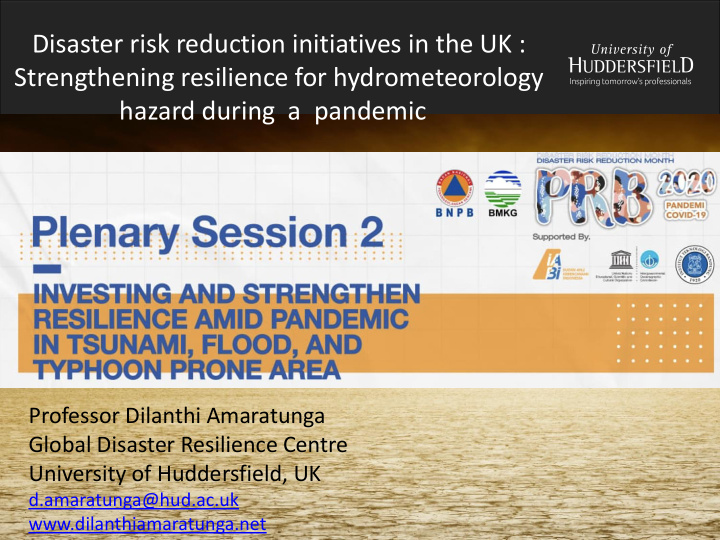



Disaster risk reduction initiatives in the UK : Strengthening resilience for hydrometeorology hazard during a pandemic Professor Dilanthi Amaratunga Global Disaster Resilience Centre University of Huddersfield, UK d.amaratunga@hud.ac.uk www.dilanthiamaratunga.net
Who am I? Research Funding More than £ 20 million Publications Over 500 + 11,000 + citations
Last updated on Friday 9 October 2020 at 4:00pm
Coronavirus: facts Its spread has left businesses around the world counting costs and wondering what recovery could look like The FTSE, Dow Jones Industrial Average and the Nikkei all saw huge falls as the number of Covid-19 cases grew.
Coronavirus: facts Many people have lost their jobs or seen their incomes cut due to the coronavirus crisis Unemployment rates have increased across major economies In the US, the proportion of people out of work has hit 10.4% (IMF), signaling an end to a decade of expansion for one of the world's largest economies.
The UK’s progress on disaster risk reduction
UK – Nati tional l pandemic prep reparedness stra trategy • UK approach to pandemic response based on impact at different stage • Strategic objectives of the UK pandemic preparedness plan: – Precautionary: responding in relation to the risk – Proportionality: planning for uncertainty – Flexibility: managing the phases of pandemic response • Their guiding principles for pandemic preparedness: – Evidence based – Ethical principles for pandemic preparedness – Building on established systems and business continuity – Whole of society preparedness – Local and national coordination – International coordination and assistance
Stakeholders of the UK pandemic preparedness In the UK, pandemic preparedness strategy is developed with multi- stakeholders’ participation
Role of public health services within UK’s emergency management structure UK disaster management system is governed under the Civil Contingencies Act of 2004 Health services are integrated within this partnership as a key sector in the UK National Health Service (NHS) in England has been integrated to national disaster management system in the UK
Health services within the DRR context With the increasing number of natural hazards and their complexities, the demand for improved preparedness and response measures specifically in the health sector and their role in disaster management has been identified
“Disasters don’t stop for a virus”
Unprecedented investment on research
Unprecedented investment on research
Dealing with dual challenges: Flood risks management in the UK during the pandemic
• Established in 1995, the Environment Agency is a non-departmental public body • The Agency's overall responsibility is the protection and enhancement of the environment in England . • Environment Agency’ s priority is to protect people and the environment, and to support those we regulate during the coronavirus pandemic. • More than 3.5million properties in England and Wales are at risk from some form of flooding. Of these, around one in 12 are at high risk - equivalent to 290,000 homes. • Hundreds of thousands of households have been left more vulnerable as a result of the worst public health crisis in a generation. • Even relatively minor flooding would place disproportionate strain on people’s jobs, finances and mental health. If towns are hit by flooding in the coming months, the impact would be magnified, with particularly severe consequences for the most vulnerable in society. • It has published its approach to regulation and enforcement during the coronavirus outbreak - Environment Agency regulatory response to coronavirus
Flood warning service Continuing to protect lives and livelihoods through the flood warning service remains fundamental to the work as the nation continues to deal with the effects of coronavirus. There are systems in place to protect the flood warning service during this difficult time Flood defence work Flood defence work continues and where it is safe. We are ready to respond to flooding. During coronavirus we continue to maintain and operate our flood and coastal defences to ensure they protect people and property from flooding. We’re also maintaining our assets that support public water supply, industry, infrastructure, food production and the environment. Grants are be made available all year round to help people in high flood risk areas protect their homes before flooding strikes
The health crisis stress-tests our ability to cooperate, learn and adapt in the face of deep uncertainties and rising risks • COVID-19 is much more than a public health emergency • The COVID-19 disaster is what the international scientific community has recognised for years: that in an increasingly interdependent world, our lifestyles, our choices mean that hazards are spread throughout communities, societies and economies in complex ways that lead to systemic and cascading risks. • Dealing with multiple challenges is not easy, however, steps need to be taken to prepare ourselves to face the unknown
Disaster risk reduction initiatives in the UK : Strengthening resilience for hydrometeorology hazard during a pandemic Professor Dilanthi Amaratunga Global Disaster Resilience Centre University of Huddersfield, UK d.amaratunga@hud.ac.uk www.dilanthiamaratunga.net
Recommend
More recommend